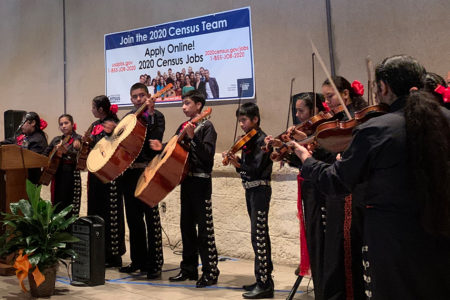
Share On Social!
Every 10 years, the U.S. Government performs its duty of collecting a full count of the people residing in America. This decade’s survey is well underway.
This initiative, mandated by Article I, Section 2 of the Constitution, provides the necessary data to allocate critical funds, assess the greatest needs of that moment, and gather other information that impacts people’s daily lives. Here’s what all Latinos need to know.
While the outbreak of the COVID-19 outbreak has impacted the U.S. Census Bureau’s work, the agency is pushing forward to garner as many completed surveys as possible.
“As we resume operations delayed by the —, [we recognize] that our data collections are becoming increasingly complex and rely upon new technologies, innovations and reforms, it is imperative that we consider public, private, and not-for-profit sector needs for relevant and quality data,” Census Bureau Director Dr. Steven Dillingham said in a recent statement. “The importance of more and better data for decision making will continue as the heart of the Census Bureau mission.”
Supreme Court Update, October 15, 2020: The Supreme Court ruled on Oct. 13, that Trump administration can end census field operations early despite delays and difficulties related to the ongoing pandemic.
- Internet self-response will be available through 11:59 p.m. Hawaii Standard Time (HST) Oct. 15 (5:59 a.m. Eastern Daylight Time on Oct. 16).
- Paper responses must be postmarked by Oct. 15, 2020.
Collecting Census Data Amid Pandemic
As the country experienced shelter-in-place orders and city-wide shut downs, some of the Bureau’s work—especially its door-to-door operations—experienced setbacks.
“The truth is that the only thing in charge of the census right now is the virus,” said Kenneth Prewitt, a Columbia University professor who directed the Census Bureau during the 2000 count, told the New York Times. “Not the bureau, not the president. And the virus will be in charge until it isn’t.”
Still, with the internet boom that has taken place between 2010 and 2020, the Census had already prepared by implementing something truly innovative: The ability for residents to take the survey from the safety of their home online.
Last week, the Bureau even announced that it had delivered 2020 Census materials to 96% of households.
“As of today, over 90 million households have responded to the 2020 Census, with over four in five households doing so online,” the Bureau said in a recent statement. “People can still respond on their own online, over the phone or by mail — all without having to meet a census taker.” 
Despite these best efforts, however, the initial numbers aren’t looking great.
When it comes to the Latino community, the numbers aren’t looking good so far. A recent analysis of current self-response data shows that in states with high Latino populations, participation is low. These include:
- 9% in Arizona
- 4% in California
- 6% in Florida
- 8% in New Mexico
- 6% in New York
- 1% in Texas
These numbers could have detrimental impacts on the Latino community, according to the National Association of Latino Elected and Appointed Officials (NALEO).
“As the self-response rates in these highly populated states affect the national average of 61.4%, there are several indicators that Latino self-response rates are lower, and that the higher the Latino share of a population, the lower the total self-response rate is for that location,” the group said in a recent statement.
Working for Latino Representation
Historically, Latinos and other minority groups have been undercounted due to circumstances such as a lack of knowledge about the survey, fear-based on misunderstanding, and an absence of the Bureau’s focus on these communities — something that has changed in recent years.
The Bureau has partnered with numerous local and/or minority-focused groups to spread the word about the Census — all in hopes of garnering more participation.
Luckily, those organizations have responded in kind because they say this initiative is too important to overlook.
“Our organization’s work to reach Latinos and motivate higher self-response rates in the 2020 Census is in full flux as census operations resume amid COVID-19,” NALEO Educational Fund CEO, Arturo Vargas, stated. 
They are doing so by partnering in partnerships, including those with media groups such as Telemundo.
“Our relationship with Telemundo has been critical in connecting our work to Latinos through Spanish-language media,” Vargas, stated. “We know that during the economic turmoil brought on by COVID-19, Census Bureau operational changes, and misinformation around the census, Latinos continue to have lower self-response rates than the general population. Our efforts with Telemundo seek to mitigate these barriers to participation and empower Latinos with the information we need to make ourselves seen and heard by participating in the census.”
To remedy this, there has been a recent push to gain more interactions well as participation, from disadvantaged neighborhoods and those who live there by the Census Bureau. Still, anti-immigrant rhetoric coming from national leaders—even those in the White House—has created fear among those in communities of color, especially undocumented residents.
Nevertheless, Census officials make two things clear: it is critical that everyone living in the U.S. fill out the survey.
“It is all of our duties to make sure people understand that the census is secure and it’s safe,” Dennis Johnson, deputy regional director of the Bureau’s Denver region, which makes up one-sixth of the country, said at a Census event in San Antonio last October. “Individual information about you or I can never be released. No information provided in the census can be used in a personal way against anyone. It can’t be used for any purpose whatsoever.”
How You Can Participate and Help with the Census
What’s needed most in this issue is for everyone residing in America—regardless of citizenship status—take the U.S. Census.
More, the Bureau has hired millions of people across the country to work with their agency in this effort. Census representatives say they still need more folks to help to garner a full count, which includes employment with the agency.
On average, part- and full-time employees can make up to $18 an hour for their services.
More than anything else, the Bureau and its partners say spreading awareness in order to get as many people to participate as possible is critical.
“We need the census to undo what the census has told us,” State Representative for Texas’ 123rd district, Diego Bernal, said at a Census event in San Antonio last October. “The only way we do that is if we mobilize and that we convince our neighbors that there is absolutely nothing to fear.”
Explore More:
Increasing Civic EngagementBy The Numbers
50
percent
of big U.S cities have a local board of health



